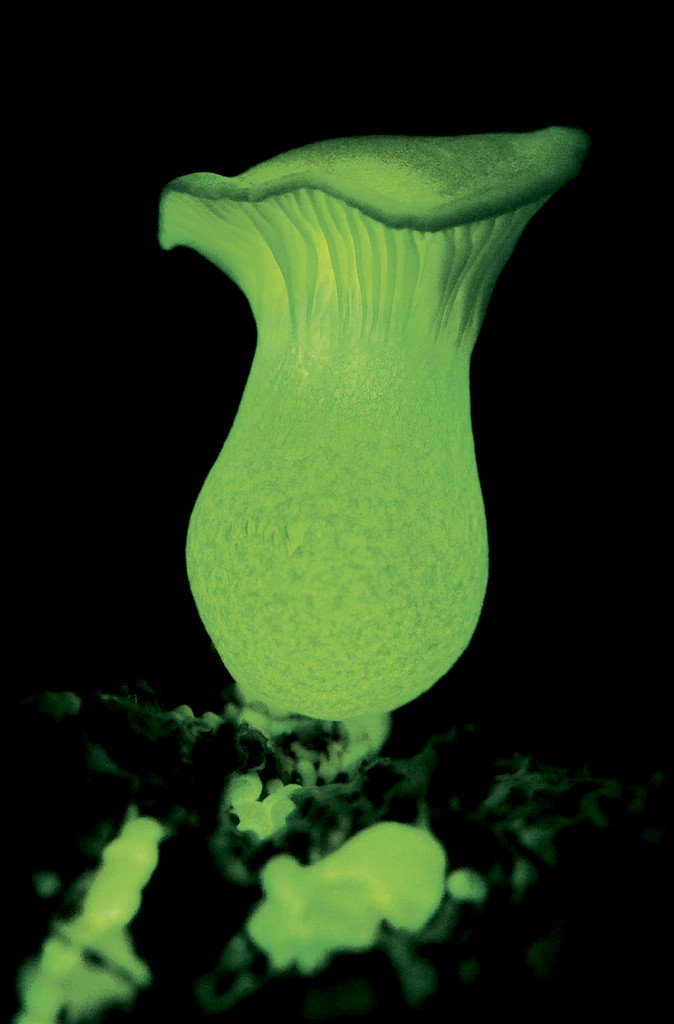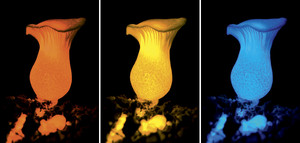
Cassius Stevani/IQ-USP
The green light emitted by Neonothopanus gardneri is visible on dark nightsCassius Stevani/IQ-USPA street illuminated by bright trees, instead of light posts. The makings of a dream, but not impossible to chemist Cassius Stevani, a professor at the University of São Paulo Chemistry Institute (IQ-USP). “But we have to be careful, we do not want the natural forest to emit light at night,” he warns. Although beyond the realm of reality, the science-fiction scenario is based on Stevani’s research on bioluminescent mushrooms, principally the species Neonothopanus gardneri, from the Mata dos Cocais forest in the state of Piauí (see Pesquisa FAPESP Issue No. 168). He and a series of collaborators, mostly Russians and Brazilians, have just unlocked the mystery behind an important part of the chemical reactions that make mushrooms glow green, as shown in the article published on April 26, 2017 in the journal Science Advances.
An important part of the research was discovering that hispidine, a molecule with pharmacological properties found in most plants, is a precursor of luciferin, a substrate essential for light production in mushrooms. Hispidine is also found in non-luminescent mushrooms, in which it is responsible for an orange color and for protecting them against damage caused by sunlight.
According to the sequence of chemical reactions revealed by the group of researchers, luciferin reacts with oxygen through the action of the enzyme luciferase and gives rise to excited oxyluciferin which, when it decays into the ground state, emits a photon—and therefore light. Next, oxyluciferin is converted into caffeic acid through the action of another enzyme. This is another important finding because caffeic acid was already known to be a precursor of hispidine. Stevani explains that this is how the cycle comes full circle. “The molecules involved in bioluminescence are recycled, which explains the small amount of hispidine in mushrooms: it is constantly formed, then reacts, and the bioluminescence cycle continues.” As this process consumes oxygen, it can be a way for the mushroom to fight oxidative stress damage.
Trees and other plants also produce caffeic acid, and this is the source of the joke of suggesting genetic manipulation so that they also produce the enzymes needed to complete the reaction and glow. “Luminescent orchids could also be produced for the ornamental plant market” the chemist suggests. U.S. biochemist Hans Waldenmaier, who completed his doctorate under Stevani in 2016, plans to set up a company to produce bioluminescent plants in the United States. The objective is not just decorative. “Maybe one day it will be possible to use this system as a reporter for the biological processes of plants and apply the knowledge to human health problems,” says the IQ-USP professor. Fluorescent proteins used as a bright genetic marker, or reporter, earned Osamu Shimomura, Roger Tsien and Martin Chalfie the 2008 Nobel Prize for Chemistry, precisely for their importance in visualizing biochemical processes. In that case, it was a fluorescent protein produced by jellyfish, widely used in laboratories around the world.
Productive chemistry
The results obtained in the Science Advances article arose from the collaboration between Stevani and the Russian chemist Ilia Yampolsky of the Institute of Bio-organic Chemistry in Moscow, a partnership that emerged in an unusual way. When Stevani learned, from students coming back from an international congress, that Yampolsky was looking to characterize molecules responsible for bioluminescence in mushrooms, the Brazilian researcher contacted him to propose working together. But he contacted him too late. The results of the study had already been submitted for publication, based on a mushroom very similar to the Brazilian mushroom, namely Neonothopanus nambi, from Vietnam. In the competitive academic environment, defeat by a researcher who began working in the field only recently could be cause for spite and enmity. But the opposite occurred. To obtain the results presented in Science Advances, each contributed his expertise—for the Russian, it was in the synthesis of organic compounds and for the Brazilian, it was in chemical mechanisms. In São Paulo, others also contributed: chemists Erick Bastos and Paolo di Mascio of the IQ, and Anderson Oliveira of the Oceanographic Institute; and pharmacists Felipe Dörr and Ernani Pinto, of the School of Pharmaceutical Sciences, all at USP.

Cassius Stevani/IQ-USP
Altered images illustrate what the mushroom would look like if it produced alternative substratesCassius Stevani/IQ-USPIn addition to clarifying which molecules are present in the bioluminescence reaction, they have found that luciferase is versatile. Yampolsky synthesized variations of luciferin that, when reacting with luciferase, also generate light. As these molecules are not produced by the mushrooms, the reaction was produced inside an apparatus, known as the luminometer, which recorded the presence of light. The difference is that the light would have a wavelength different from the green observed in nature, and if the reaction occurred in nature, mushrooms would glow in other colors, as in the altered images that illustrate this article: “poetic license” in the words of the Brazilian chemist.
In addition to pure chemistry, fiction and technological applications, Stevani also dabbles in biology by investigating the ecological significance of mushroom luminescence. The results obtained by Waldenmaier in his doctoral thesis are still being prepared for publication, but it can already be said that videos and field experiments suggest that brightness attracts insects and creates a true miniature ecosystem. Mushrooms seem to be a meeting point for fireflies, who visit them in pairs. Bush cockroaches (Ellipsidion humerale) eat the mushrooms and are hunted by spiders. All of them, Stevani suggests, are attracted by the light that spreads much farther than scent in the forest environment. While this is happening, animals become covered with spores and help spread the mushrooms. After all, because they grow near the ground where it is more humid, there is no wind to disperse the reproductive spores. In collaboration, everyone ends up a winner.
Project
Fungal bioluminescence: species survey, mechanistic study & toxicological assays (No. 13/16885-1); Grant Mechanism Regular Research Grant; Principal Investigator Cassius Vinicius Stevani (USP); Investment R$183,183.40 + US$ 58,141.94.
Scientific article
KASKOVA, Z. M. et al. Mechanism and color modulation of fungal bioluminescence. Science Advances. April 26, 2017.
